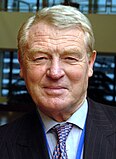1996 United Kingdom local elections
| |||||||||||||||||||||||||||||||||||||
All 36 metropolitan boroughs, 14 out of 25 unitary authorities and 100 out of 262 English districts | |||||||||||||||||||||||||||||||||||||
|---|---|---|---|---|---|---|---|---|---|---|---|---|---|---|---|---|---|---|---|---|---|---|---|---|---|---|---|---|---|---|---|---|---|---|---|---|---|
| |||||||||||||||||||||||||||||||||||||
 Colours denote the winning party, as shown in the table of results. | |||||||||||||||||||||||||||||||||||||
The 1996 United Kingdom local elections were held on 2 May 1996.[1][2] They were the last local elections until 2010 to show a decline in the number of Conservative councillors and an increase in the number of Labour councillors.
The main opposition Labour Party gained 468 seats, bringing their number of councillors to 10,929. Their share of the vote was projected to be 43%, 4% down on the 1995 local elections.
The governing Conservative Party lost 607 seats and were left with 4,276 councillors - still in third place behind the Liberal Democrats. The Conservatives' projected share of the vote was 29%, a 4% increase since the previous local elections in 1995.
The Liberal Democrats gained 136 seats and had 5,078 councillors after the elections.
Summary of results
[edit]| Party | Councils | Councillors | |||||||
|---|---|---|---|---|---|---|---|---|---|
| Gain | Loss | Change | Total | Gain | Loss | Change | Total | ||
| Labour | +11 | 87 | +466 | 1,744 | |||||
| Liberal Democrats | +5 | 23 | +150 | 641 | |||||
| Conservative | -1 | 3 | -577 | 518 | |||||
| Other | 0 | 0 | +3 | 3 | -39 | 127 | |||
| No overall control | +1 | -16 | -15 | 34 | — | — | — | — | |
Source: Parliamentary Research Briefing on 1996 Local Election[3]
England
[edit]Metropolitan boroughs
[edit]All 36 metropolitan borough councils had one third of their seats up for election.
Unitary authorities
[edit]Whole council
[edit]These were the first elections to 13 more unitary authorities established by the Local Government Commission for England (1992). They acted as "shadow authorities" until 1 April 1997.
| Council | Previous control | Result | Details | ||
|---|---|---|---|---|---|
| Bournemouth | New Council | No overall control | Details | ||
| Brighton and Hove | New Council | Labour | Details | ||
| Darlington | New Council | Labour | Details | ||
| Derby | New Council | Labour | Details | ||
| Leicester | New Council | Labour | Details | ||
| Luton | New Council | Labour | Details | ||
| Milton Keynes ‡ | New Council | Labour | Details | ||
| Poole | New Council | Liberal Democrats | Details | ||
| Portsmouth | New Council | Labour | Details | ||
| Rutland | New Council | Independent | Details | ||
| Southampton | New Council | Labour | Details | ||
| Stoke-on-Trent | New Council | Labour | Details | ||
| Thamesdown | New Council | Labour | Details | ||
‡ New ward boundaries from predecessor authorities
Third of council
[edit]In 1 unitary authority one third of the council was up for election.
| Council | Previous control | Result | Details | ||
|---|---|---|---|---|---|
| Hartlepool | Labour | Labour hold | Details | ||
District councils
[edit]In 100 districts one third of the council was up for election.
These were the last elections to the district councils of Blackburn, Halton, Peterborough, Reading, Slough, Southend-on-Sea, Thurrock and Wokingham before they became unitary authorities by the Local Government Commission for England (1992).
These were also the last elections to the district councils of Gillingham, Hereford, Leominster and South Herefordshire before they were abolished and replaced by unitary authorities by the Local Government Commission for England (1992).
References
[edit]- ^ Rallings, Colin; Thrasher, Michael. Local Elections Handbook 1996 (PDF). Local Government Chronicle Elections Centre. Retrieved 3 May 2016.
- ^ "Council compositions". The Elections Centre. Retrieved 3 May 2016.
- ^ "Parliamentary Research Briefing on 1996 Local Election" (PDF).



